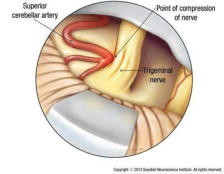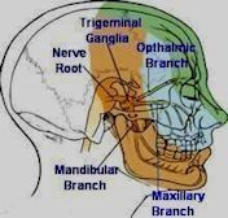


Trigeminal Neuralgia
Trigeminal Neuralgia can cause extremely severe pain over an area of the face supplied
by the Trigeminal Nerve. It is said that the pain can sometimes be so severe that patients
may at times consider suicide. The pain can be sudden and can be triggered by anything
like touching the face, using a tooth brush or even by sudden changes in the outside
temperature. Most often the cause is unknown. Females are more often affected than
males.
The Trigeminal nerve is one of 12 nerves arising from the brain. The short nerve ends in
an expanded mass called the ganglia from which 3 branches exit the skull to supply the
different areas of the face. The pathology most
often affects either the maxillary or mandibular
division of the nerve affecting the particular area
supplied by that division (Blue or Brown shades on the picture). It usually affects one side
of the face but sometimes both sides can be affected. Quite often the pain involves the
jaw or teeth that the person may think that it is a dental problem and may visit a dentist.
Once the dentist rules out a dental cause the diagnosis is often made by the person's
symptoms alone.
Investigation : An MRI scan should be done to rule out other causes of pain like tumours
affecting the nerve, sinusitis or occasionally Multiple Sclerosis. Sometimes an enlarged
vessel pressing on the ganglion causing the neuralgia may be picked up on the scan.
Treatment:
Drugs: The drugs normally used for epilepsy often control the acute pain.
•
Carbamazine can be very effective initially but may become less effective later.
•
Gabapentin, Baclofen, Oxacarbazepine, Pregabalin are other drugs that can be tried.
With many of these drugs side effects like sickness, drowsiness, double vision, tiredness may occur. To reduce the side effects
dossage may need altering. It is however worth persisting with the medication as the side effects usually settle after a while.
However you must discuss any side effect with your doctor who will decide if you should continue with the drug.
Other procedures: If the medication does not control the symptoms adequately other specialised treatments should be
considered.There are a number of procedures available but most of them do not guarantee total cure for the condition.
1.
Injection of Glycerol
2.
Percutaneous radiofrequency thermocoagulation
3.
Baloon compression of the ganglia
4.
Gamma Knife Radiosurgery
5.
Microvascular Decompression
All these procedures except microvascular decompression aim to control symptoms by destroying the ganglion or nerve. Although
pain can be controlled, many of the procedures leave a numb area of the face supplied by the nerve. The loss of sensation can
sometimes be disabling. Also any procedure where a needle is inserted in to the brain, complications like bleeding in the brain and
paralysis of muscles that control eye movements can occur.
Injecting glycerol and radiofrequency thermocoagulation are procedures done by inserting a needle or a fine tube into the ganglion
under general anaesthetic. The needle or probe is positioned accurately in the brain by using x-rays to guide them.
In glycerol injection a small quantity of glycerol is injected in to the ganglion.
In radiofrequency coagulation heat is applied directly on the ganglion through the needle.
In balloon compression, a tiny balloon inserted through a needle is inflated over the ganglion to compress and destroy it.
Gamma knife radio surgery otherwise called stereotactic radiosurgery involves directing an accurate beam of radiation at the
ganglion. It does not require a general anaesthetic nor does it involve any form of invasive surgery. Patients can usually be
discharged home the same day shortly after the procedure.
Microvascular decompression: Many consider vascular compression of the ganglia by an
engorged vessel to be the main cause of neuralgia. Decompressing the vessel is a more
invasive procedure involving opening the skull under a general anaesthetic. Although this is
the only procedure that can be considered to cure the problem without a side effect, it is an



Information for the General Public